History of Barnaul
According to archaeological research, the first settlements in the territory of present Barnaul existed in the Stone Age. 63 archaeological monuments have been preserved to this day. These are the sites of ancient settlements and burial mounds located mostly on the left bank of the Ob River - in Nagorny (mountain) part of Barnaul, in the settlements of Mohnatushka, Kazyonnaya Zaimka, Gonba, and Nauchny Gorodok.
Before the arrival of Russian settlers to Siberia, the old town-fortress of Abaksha was located here. From here, the Teleuts raided their neighbors, and the high bank of the river covered with forests was a natural barrier to their enemies.
The foundation of Barnaul is connected with the construction of a copper smelter of the Russian entrepreneur Akinfiy Demidov, who received this land for rent from the state. In 1730, he transported 200 peasants to Altai to set up factories. This year is considered the official founding date of Barnaul. In 1739, the construction of the Barnaul plant began.
In 1750, there were 17 furnaces operating at the Barnaul plant. Mining officers and engineers from the Urals began to move here for the smelting of ores and its primary processing. One of them was the talented inventor Ivan Polzunov. In 1763, he presented the project of the “fire-breathing machine” - the first steam engine in Russia, and in 1766 it was tested on the banks of the Barnaulka River.
More Historical Facts…
In 1771, Barnaul received the status of a “mining town”. In 1779, a mining school was opened to train the necessary personnel - the first of its kind in Siberia. Despite the remoteness from the center of Russia, Barnaul grew and developed. In 1835, the population of the town was about 9,000 people. The development of the town blocks was influenced by the architecture of St. Petersburg.
In 1846, the coat of arms of Barnaul was adopted, which depicted a white galloping horse and an operating silver melting furnace. This furnace is a symbol of mining and emphasizes the main wealth of Barnaul - silver. The horse was depicted on the coat of arms of Tomsk Governorate, which then included the Altai region of the Russian Empire. In the 18th - the first half of the 19th centuries, 90% of silver in the Russian Empire was smelted in Altai, about half of it at the Barnaul silver smelter.
Barnaul also became a major cultural, scientific and technical center of Russia. In the 19th century, world famous writers, travelers and scientists visited it during their expeditions: F. M. Dostoevsky, A. Humboldt, K. F. Ledebur, A. E. Brem. They left impressions in their diaries about the town, which struck them with its splendor, a highly educated society of mining engineers and officers, and the existence of such cultural institutions as an amateur theater, a museum, and libraries.
By the 1870s, the population of Barnaul was about 14,000 people, of which 30-45% were military, officials and members of their families. The abolition of serfdom, the depletion of natural resources, the inability of the factory management to work in the new conditions, led to the decline of mining and the closure of the Barnaul silver smelter in 1893.
But at the same time, the town became a major trading center of a developing agricultural region. Barnaul had a leather, candle, brick, brewing, soda, fur coat, sawmill, and other industries. This allowed Barnaul goods to enter not only the Russian, but also the international market.
In 1915, the Altai Railway was opened, which further accelerated the development of Barnaul, the population reached 40,000 people. On May 2, 1917, a large fire broke out in Barnaul. 60 blocks burned out. Up to 20,000 people were left homeless, 34 people died. Urban architecture suffered greatly and a lot of buildings, especially wooden ones, perished in the fire.
In the 1920s-1940s, Industrialization and collectivization greatly influenced the development of Barnaul. Residents of villages and small towns moved to the city, which became the center of the regional agro-industrial complex. In 1923, the central city power station came into operation.
In 1932, the construction of the largest textile factory in Western Siberia began in Barnaul together with a special “social town” with residential buildings, kindergartens, schools, medical facilities for its workers. In 1933, the first higher educational institution in the city was organized - Barnaul State Pedagogical Institute.
In 1937, in connection with the formation of a separate Altai region (Altai Krai), Barnaul received the status of its administrative center. The population of the city was 118,200 people.
During the Second World War, about 100 industrial enterprises from Moscow, Leningrad, Odessa, Kharkov, and other cities were moved to Barnaul. They became the basis of the industry of the city and were not returned after the war. About half of the cartridges used by the Soviet Army during the war were produced in Barnaul. In 1945, the population of Barnaul was 210,500 people.
The postwar years were marked by the rapid development of the chemical industry. An attempt was also made to solve the housing problem and relocate the Barnaul residents from dilapidated wooden houses to relatively comfortable mass produced five-story apartment buildings. In 1989, the population of Barnaul was about 601,000 people.
With the collapse of the USSR and the changing political and economic situation in the country, the largest industrial enterprises of Barnaul were on the verge of bankruptcy. Other areas of the economy began to develop instead of heavy industry: trade, services, construction, and food industries.
From 2001-2002, Barnaul overcame the economic crisis of the 1990s. Private business began actively investing in services and entertainment. New investors partially reanimated local industry.
Architecture of Barnaul
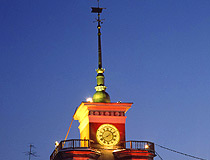
House with a spire - one of the symbols of Barnaul
Author: Konstantin Vorobev
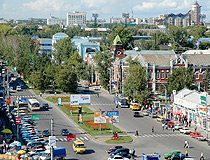
In the center of Barnaul
Author: Konstantin Vorobev

Old wooden house in Barnaul
Author: Vladimir Kharitonov
Barnaul - the Origin of the Name
There are several hypotheses about the origin of the name of this city.
For a long time, the most popular version was that the word “barnaul” was translated from the Kazakh language as “good pasture” or “Barn’s aul” (“Barn’s village”), where Barn was the name of one of the nomads of the Siberian Khanate. But, according to historians, this version is nothing more than folk etymology, because the Kazakhs don’t have such names as Barn, and they never roamed in this region, and they have a special term for a good pasture (“jailau”).
Another version is tied to the name of the Barnaulka River, which on the maps of the late 18th century is named Boronoul or Boronour, where “boro” in many Turkic and Mongolian languages goes back to the word “wolf”, and “ul” in Turkic means “river”. Thus, Barnaul means a wolf river or, possibly, a wolf lake. The wolf was considered a sacred animal among the indigenous people of Altai.
Barnaul historian and archaeologist A. Umansky tried to translate the name of the river suggesting that it had Teleut roots. In his opinion, this word is as a result of linguistic metamorphoses from the Teleut word “porongyul”, where “po-rongy” means “muddy water”, and “ul” means “river”. Thus, Barnaulka is translated as “muddy river”. This river really abounds in organic and mineral substances, including sand.
Barnaul - Features
Barnaul is located in the forest-steppe zone of the West Siberian Plain, in the upper reaches of the Ob River, mainly on its left bank, at the confluence of the Barnaulka River with the Ob. The distance to Moscow is about 3,600 km. The nearest major city is Novosibirsk (230 km). Barnaul is located at the same latitude as Hamburg, Dublin, Liverpool, Minsk, Petropavlovsk-Kamchatsky, Samara, Magnitogorsk, and Edmonton.
The climate in the city is continental with frosty, moderately severe, snowy winters and warm , moderately humid summers. The coldest month of the year is January (the average temperature is minus 15.5 degrees Celsius), the warmest month is July (plus 19.9 degrees Celsius). The number of sunny days in Barnaul is 230 days, which is comparable with the southern resort cities of Russia.
Barnaul is one of the most important economic centers of Western Siberia. The city’s economy is mainly based on trade and services. The basis of its industrial complex is made up of about 120 large and medium-sized enterprises with 22 thousand employees. The largest increase in production volumes is shown by enterprises manufacturing vehicles, equipment, as well as metalworking, chemical, processing enterprises.
This city is a major transport hub. The federal highway A322 Barnaul - Rubtsovsk - the border with the Republic of Kazakhstan begins here. Railways belonging to the West Siberian Railway pass through barnaul. G.S. Titov International Airport is located 17 km west of the city (regular flights to Moscow, St. Petersburg, Irkutsk, Krasnoyarsk, Sochi, and others). There is a passenger river station and a cargo river port on the Ob River.
Initially, the city was built on the model of St. Petersburg, which largely determined the appearance of its central part.
Why is it worth to visit Barnaul?
Learn about the unique role of Barnaul in the history of the Russian Empire. Starting from 1730 for almost 150 years, about 90% of the silver of the Russian Empire was smelted in Barnaul. The production management of the Barnaul silver smelter was provided by mountain officers, highly educated officials, and military personnel who had the highest social status. Thanks to them, secular life developed in Barnaul, and this town became the cultural and intellectual center of Siberia.
See the preserved heritage of the 18th-19th centuries. Historically, Barnaul developed as a mining, merchant, then as an industrial city. All these epochs of development can be observed in the preserved architecture.
Taste local organic products. The climate of Barnaul allows to grow crops with a high content of useful healthy components. Fertile lands and plenty of sunshine contribute to this.
Improve health. Due to the proximity of a large forest, a 15-minute drive from the city center there are spa- and sports facilities, ski resorts, recreation centers, and hotels where guests and tourists can rest and undergo treatment. For lovers of extreme sports, in the upland part of Barnaul there is the ski complex “Avalman”. In winter, ski equipment rental and ski lifts are available here. In summer, this complex is a great place for walks, picnics, celebrations with a beautiful view of the Ob River.
Main Sights of Barnaul
Thanks to the rich cultural heritage, the tourist and recreational cluster “The Mining-Metallurgical Town of Barnaul” was created in the old city. Today, the territory of the historical center is adapted for a comfortable stay of tourists. Here you can see architectural monuments of the 18th-19th centuries, visit museums, souvenir shops, cafes, shopping and entertainment centers, and stay in hotels.
Altai State Museum of Local Lore - the oldest museum in Barnaul. The museum building is a monument of architecture, history and culture of the mid-19th century, the former mining laboratory located in the historical center of the city. In total, there are about 190,000 exhibits. The most interesting are collections on archeology, the history of mining in Altai, rare books, products of Altai stone-cutters, ancient Siberian coins. Polzunova Street, 46.
Mountain Pharmacy (1793-1794) - a monument of architecture of federal significance. Inside, there is the Museum of the History of Pharmacy Business in Altai. Here you can also buy unusual souvenirs and even have a delicious lunch. Polzunova Street, 42.
Museum “Stone World”. About 1,000 samples of natural stones and products of Altai craftsmen are presented here. Here you can also buy works made by stone carvers. Polzunova Street , 39.
Museum “World of Time” - one of the first private museums in Barnaul. Here you can see and even touch artifacts reflecting the spirit of various eras. From the tools of an ancient man to a Soviet diving suit (about 10,000 exhibits). Matrosova Street, 12.
State Art Museum of Altai Krai. This museum has more than 13,000 works of art. The collection consists of sections of Orthodox art of the 16th-20th centuries, Russian art of the 18th-20th centuries, professional and folk art of Siberia and Altai at the end of the 18th-21st centuries, as well as small sections of ancient and Western European art. The most extensive exhibition is a collection of works created by professional artists of Altai. Gorky Street, 16.
Pokrovsky Cathedral (1898-1903) - the largest and oldest Orthodox church in Barnaul built of red brick in neo-Byzantine style. Nikitina Street, 137.
Malo-Tobolskaya Street - one of the oldest streets in Barnaul turned into a pedestrian street.
Nagorny (Mountain) Park - a 14-hectare park located in the southern part of Barnaul, on a wide and high hill near the watershed of the Ob and Barnaulka rivers. Its elevated location offers a wide panorama of the city and the Ob River valley. 7-meters high white letters “BARNAUL” are installed here resembling the famous Hollywood Sign in Los Angeles, California, the US. The embankment of the Ob (opened in June 2018) and Nagorny Park are connected by stairs.
Barnaul Arboretum (The Arboretum of the Scientific and Research Institute of Horticulture of Siberia named after M. A. Lisavenko) is located in the southern part of Barnaul, one of the most beautiful places in the city. The collection includes more than 1,000 botanical species, hybrids, varieties of trees and shrubs. Zmeinogorskiy Trakt, 49.


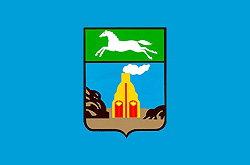
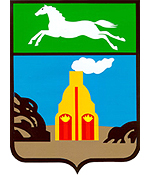



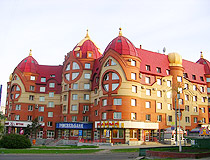
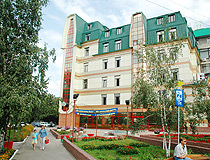
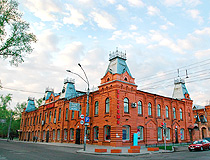
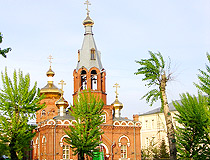
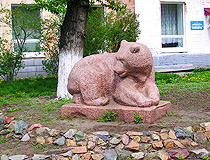
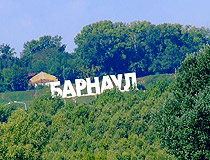
The comments of our visitors